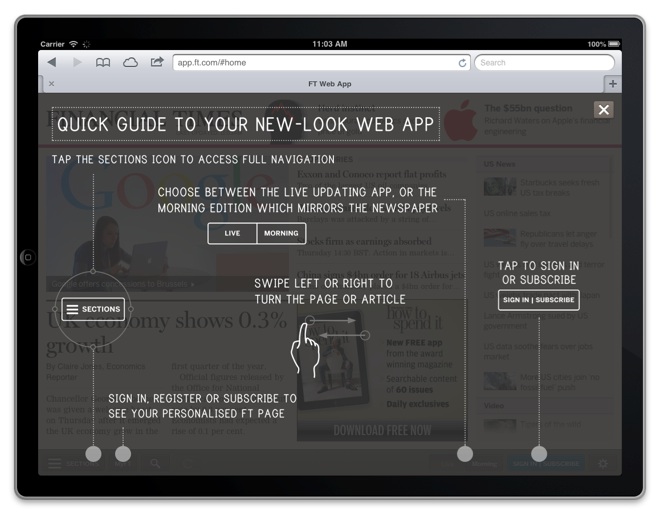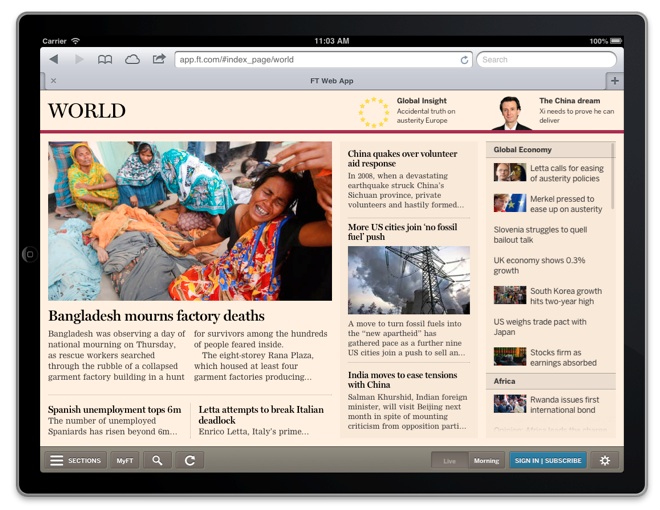 Everyone knows mobile is taking over. All you have to do is stick your head out the window, snap an Instagram, and you’ll see it: Little computers that we can hold in our hands are everywhere.
Everyone knows mobile is taking over. All you have to do is stick your head out the window, snap an Instagram, and you’ll see it: Little computers that we can hold in our hands are everywhere.
According to an Econsultancy and Adobe trend report, marketers see mobile optimization as the number one opportunity in 2013; yet they struggle with executing on an effective mobile content strategy. And while there are plenty of great studies out there that portend mobile’s takeover of the web, there’s not much information about the best (and worst) approaches to publishing content that is mobile-friendly. Obviously, mobile is a whole new ball game. So how do we play?
To get you started, here is a list of five easy ways to deliver effective content experiences on mobile platforms. Using real life examples, from McDonalds’ use of responsive design to Oreo’s awesome real-time and video campaigns, there is plenty of useful advice to be gleaned from how the pros publish content on mobile.
#1: Make your content readable on mobile
This one sounds like a no-brainer, but too many businesses are simply failing to make their content accessible on the small screen. One eye-opening study suggested 98 percent of small and medium business websites were not ready for mobile. You know the feeling: You’re browsing the web on your smartphone, only to come to the brick wall of an impossible-to-read website — or worse, you encounter a big alert that tries to force you to download an app.
The obvious solution here is to make your site fit for tablet and smartphone reading. One of the most popular tactics for doing this is with a responsively designed website. Responsive web design simply means building your site (whether it’s a blog or an e-commerce platform) with flexibility for all devices in mind. So when a user with a smartphone comes to your site, the objects on the screen will automatically adjust to fit the screen. You build once, and it fits nicely on all devices, from PCs to tablets and smartphones.

Example from the pros: When McDonalds Canada put out its Your Questions campaign, it knew a huge portion of readers would be accessing the interactive microsite from handheld devices. So the company made the whole thing responsive to automatically adjust the screen no matter what device customers choose to view the content on.
Takeaway: The result of a responsive web design means you just build once and can provide visitors with an easily usable content experience.
#2: Make your site feel like a mobile site
Despite responsive design’s huge benefit to marketers, an incredible mobile reading experience is so much more than simply making your content fit on a smaller screen. Doing that sometimes feels like putting a radio show on the television — the content is all there, but you are missing out on something.
Mobile is an entirely new medium and it comes with a unique way for people to interact with content. It’s all about touch, swipe, and that feeling of a full-screen, laid-back experience — simulating the “couch surfing” vibe. This is why some content publishers opt for creating a social magazine-style experience, in the spirit of Flipboard, to deliver content to mobile users in the most dynamic way possible.
The benefit of this approach is huge. Aside from providing a more familiar and enjoyable reading experience, your readers tend to view more pages, and spend far more time with your content compared with other websites that were built with click and scroll in mind.
An added benefit to this approach is that marketers are given a natural way to show full-screen ads and/or call-to-action widgets. So, for instance, in between your full-screen articles, you can sneak in a white paper download CTA or a newsletter sign-up request without interrupting the experience.

Example from the pros: “The Toronto Star,” one of North America’s largest newspapers, built a great mobile-first, immersive experience for its tablet audience. It created a totally swipeable, full-screen magazine web app, which makes it incredibly easy for visitors to swipe to the next story, much like they would turn a printed page to keep reading.
Takeaway: Boost page views and time spent on your blog or content site with a built-for-touch, laid-back reading experience.
#3: Create custom, mobile-only assets
As you start to notice more of your readers are on mobile, another strong tactic is to build something just for them. In contrast to optimizing an existing web property, customized mobile assets are all about putting together a stand-alone content experience the user can only access through a smartphone or a tablet device.
Many brands are using this tactic to curate diverse content assets from around the web into a single, compelling mobile product. It’s a surefire way to give readers a valuable reading experience, while at the same time unifying all your efforts (e.g., all your social feeds, video, and blog content can be rolled up into one awesome experience), and potentially driving them to discover more content they otherwise might have missed.

Example from the pros:
“The Economist’s” Electionism: When the U.S. presidential elections were just starting to heat up in 2011, “The Economist” wanted to do something special for its growing tablet readership. The publisher built Electionism, a mobile-only app that leveraged its editorial content on the U.S. election, social feeds, and a curated news section from across the web.

Softchoice: Softchoice is a leading B2B technology provider, as well as a group of laser-sharp content marketers. The company recently put out a tablet and smartphone app that packaged all its various content assets into a single, unified reading experience.
Takeaway: Assemble a custom mobile-online experience to drive more content discovery and build better relationships with mobile readers.
#4: Go for web, not native (most of the time)
Three years after the iPad’s release, publishers are slowly starting to realize Apple’s App Store is not always the best place to publish content. Apps have a modern, cool factor, and many content creators rushed out of the gate to go build one. Unfortunately, apps also cost a lot of money and time to produce, and at the end of the day, they don’t always provide what readers want, as evidenced by a few tragic results.
When an app is only available through the App Store, it requires several steps for users to access it. Do you really need to put up that much friction between your story and a user’s enjoyment of it? The answer is pretty obvious. And the numbers speak for themselves: Twice as many mobile news readers prefer browsers over apps.
This is why a rock star caliber mobile content marketer often goes with a web app, or optimized website, instead of investing time and money on building a closed-off native app. With the advanced web technologies available, the user experience can be made to be indistinguishable from that of a slick native app. In addition, a leading benefit of building for the web is that all your SEO efforts and existing social traffic continues to contribute to your mobile visits.
Just one caveat: In some cases, you might want to create something a little beefier than a simple reading app. Content marketing can come in many forms, and it’s not always just text and videos. In those cases, using the more robust technology platform of native apps, as well as relying on the great exposure of an app store, might be a highly visible way to launch your branded app.


Example from the pros: “Financial Times” was the first major publisher to shirk Apple’s App Store (and 30 percent revenue cut) and go right to creating a web app, which it built using the mobile-friendly HTML5 markup language.

Native apps: Volkswagen wanted to do something big to launch one of its newest cars: It wanted to build a native app for iOS. Now that’s classy! And it probably couldn’t have executed its content idea at the required level of quality if the brand had chosen to go with a web app rather than one that was designed specifically to optimize the mobile experience.
Takeaway: Most mobile content marketing is better served from the web — but if you are building a big tool or game, you may want to “go native.”
#5: Get on the hot mobile social networks
From Vine to Instagram, a number of social media sites are emerging that focus primarily on the mobile channel. And they are gaining members by the millions — members who are just waiting to be entertained by great brand content. Search out where your audience might be hanging out on mobile, find their favorite apps, and start entertaining, educating, and bringing your brand there.
Not only do these apps give you a great way to show the fun side of your brand, but they also can provide an easy way to curate or share content that keeps brand conversations flowing during those times when you are working to create more substantial content pieces.

Examples from the pros: By now, you might have heard of Oreo’s display of genius “real-time” marketing at the Super Bowl by hammering out a single, perfectly timed Twitter pic during the blackout. But this isn’t the only time the cookie maker has stood out as an exemplary mobile content marketer. As you’ll see below, Oreo has an incredible knack for entertaining and building its brand on mobile social networks. For example, Oreo has a great Vine feed packed with tons of helpful and funny videos, including the one below, which shows how to make an Oreo kebab.

“The Wolverine” movie made history and the first ever movie trailer on Vine, a little video social network that you might have heard of. Watch the full 6 seconds of it:
Embed code: <iframe class=”vine-embed” src=”https://vine.co/v/bDExaiMjJ1F/embed/simple” width=”480″ height=”480″ frameborder=”0″></iframe><script async src=”//platform.vine.co/static/scripts/embed.js” charset=”utf-8″></script>

GE’s also got an exceptional Instagram feed that showcases beauty shots of big, heavy machines. As its follower count shows, people love it.
Takeaway: Popular mobile apps can be your ticket to publishing content that entertains and connects the audience to your brand.
Want insights on how the most successful content marketers are using techniques like email, mobile content, and more? Read CMI’s eBook: Building the Perfect Content Marketing Mix: Internal Processes and Content Marketing Strategy Tactics.
